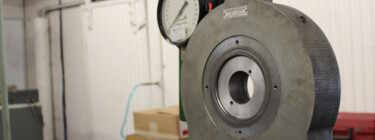The AISC Steel Construction Manual, 13th Edition has this to say about anchor rod nut installation.
“The majority of anchorage applications in buildings do not require special anchor rod nut installation procedures or pretension in the anchor rod. The anchor rod nuts should be “drawn down tight” as columns and bases are erected. This condition can be achieved by following the same practices as recommended for snug-tightened installation in steel-to-steel bolted joints in the RCSC Specification. That is, most anchor rod nuts can be installed using the full effort of an ironworker with an ordinary spud wrench.
When, in the judgment of the owner’s designated representative for design, the performance of the structure will be compromised by excessive elongation of the anchor rods under tensile loads, pretension may be required. Some examples of applications that may require pretension include structures that cantilever from concrete foundations, moment-resisting column bases with significant tensile forces in the anchor rods, or where load reversal might result in the progressive loosening of the nuts on the anchor rods.
When pretensioning of anchor rods is specified, care must be taken in the design of the column base and the embedment of the anchor rod. The shaft of the anchor rod must be free of bond to the encasing concrete so that the rod is free to elongate as it is pretensioned. Also, loss of pretension due to creep in the concrete must be taken into account. Although the design of pretensioned anchorage devices is beyond the scope of this manual, it should be noted that pretension should not be specified for anchorage devices that have not been properly designed and configured to be pretensioned.”
So, in a nutshell, what does this mean?
It means, that in normal circumstances, the normal effort of an ironworker with a regular spud wrench is sufficient to tighten the nuts on anchor bolts. In the event that special pretensioning is required, the design engineer should have carefully designed the anchor assembly specifically for that purpose and there should be detailed instructions so that the pretensioning is carried out properly.

Thanks Dane!
Perfect answers to every question!
Happy Friday
Syd
What is the number of ft lbs on a rachet to tighten nut on a 1/2” anchor bolt into floor concrete?
@Mario- For pre-installed anchor bolts (cast in place) the AISC only recommends that they be tightened snug tight. If you are using a proprietary post installed anchor, you would need to refer to that manufacturer’s recommendations.
What is the torque value for 1/2” Hilti mechanical wedge anchor
@PJ- Apologies, but we do not typically resell Hilti items and are unfamiliar with their installation recommendations.
good afternoon,
The thread length indicated in the ASME B18.2.6 standard (bolts A325 and A490) is a minimum length?
@Diego- it is neither a minimum nor a maximum. The thread length is controlled by the grip gaging length, and the body length. As the body length varies, and the grip varies, the thread length will vary. The ASME B18.2.6 standard defines tolerances for both the body length and the grip length, but not for the thread length.
is it necessary to torque the liners which is hanged to the concrete. one long bolt is used.
first a vertical steel plate then concrete and after concrete again a steel plate. these 3 are connected with a single bolt. need t torque or snug tight. drawing it briefs only to clampin
@elvisjoy- We do not have any engineers on staff, so cannot make recommendations for specific applications. You will need to consult the project engineer.